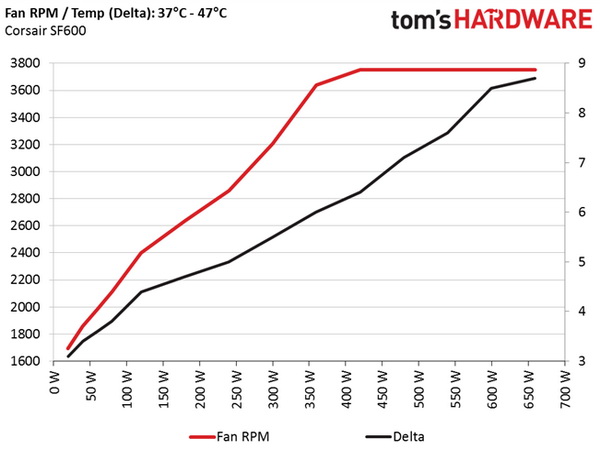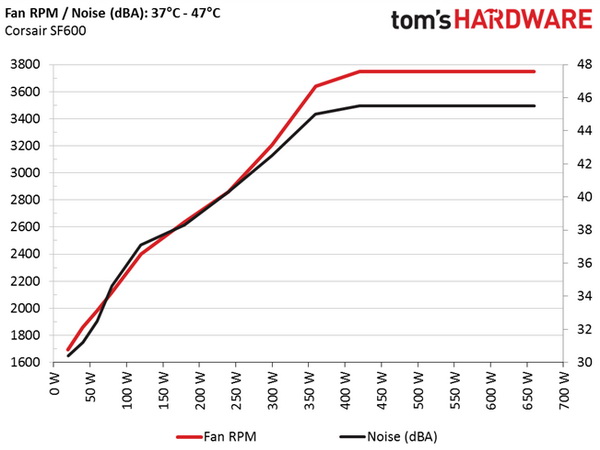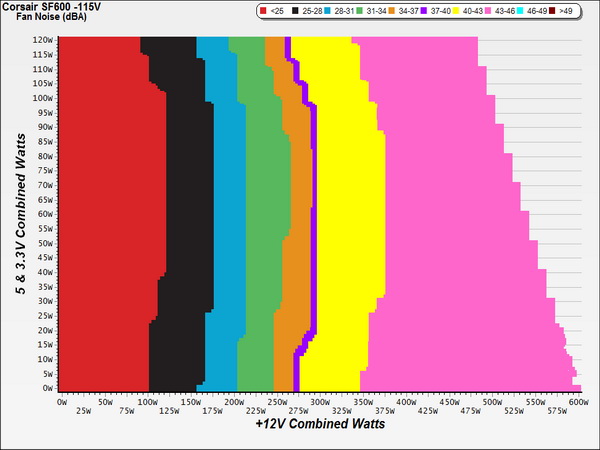Corsair SF600 Power Supply Review
We recently evaluated Corsair's SF450, which left a good impression on us. Now it's time to test the family's flagship SF600, which can deliver 150W more power using exactly the same cable configuration.
Why you can trust Tom's Hardware
Efficiency, Temperature And Noise
Efficiency
Our efficiency testing procedure is detailed here.
Using the results from the previous page, we plotted a chart showing the SF600's efficiency at low loads, and loads from 10 to 110 percent of its maximum-rated capacity.




Under normal loads, efficiency is very high. However, that's not the case under light loads, where the SF600 can't keep up with the competition (or the lower-capacity SF450).
Efficiency At Low Loads
In the following tests, we measure the SF600's efficiency at loads significantly lower than 10 percent of its maximum capacity (the lowest load the 80 PLUS standard measures). The loads we dialed were 20, 40, 60 and 80W. This is important for representing when a PC is idle, with power-saving features turned on.
| Test # | 12V | 5V | 3.3V | 5VSB | DC/AC (Watts) | Efficiency | Fan Speed (RPM) | Fan Noise | PF/AC Volts |
|---|---|---|---|---|---|---|---|---|---|
| 1 | 1.215A | 0.491A | 0.477A | 0.195A | 19.61 | 68.38% | 1695 | 30.4 dB(A) | 0.935 |
| 11.977V | 5.048V | 3.342V | 5.055V | 28.68 | 115.1V | ||||
| 2 | 2.461A | 0.990A | 0.986A | 0.395A | 39.76 | 79.22% | 1860 | 31.2 dB(A) | 0.963 |
| 11.978V | 5.045V | 3.339V | 5.050V | 50.19 | 115.1V | ||||
| 3 | 3.710A | 1.476A | 1.496A | 5.047A | 59.85 | 83.87% | 1985 | 32.5 dB(A) | 0.975 |
| 11.977V | 5.042V | 3.336V | 5.047V | 71.36 | 115.1V | ||||
| 4 | 4.941A | 1.984A | 1.978A | 0.789A | 79.74 | 86.04% | 2115 | 34.6 dB(A) | 0.973 |
| 11.975V | 5.040V | 3.334V | 5.042V | 92.68 | 115.1V |
Higher operating temperatures prevent the fan's passive mode from kicking in. Noise output remains low in general, though we certainly couldn't say this is a quiet PSU like the previously-reviewed SF450. Efficiency takes a big hit in the 600W implementation of the same platform, which you can see during the first test where it drops below 70 percent.
5VSB Efficiency
The ATX specification states that 5VSB standby supply efficiency should be as high as possible, recommending 50 percent or higher efficiency with 100mA of load, 60 percent or higher with 250mA of load and 70 percent or higher with 1A or more of load.
We take four measurements: one each at 100, 250 and 1000mA, and one with the full load the 5VSB rail can handle.
Get Tom's Hardware's best news and in-depth reviews, straight to your inbox.
| Test # | 5VSB | DC/AC (Watts) | Efficiency | PF/AC Volts |
|---|---|---|---|---|
| 1 | 0.102A | 0.52 | 72.22% | 0.101 |
| 5.058V | 0.72 | 115.1V | ||
| 2 | 0.252A | 1.28 | 79.50% | 0.196 |
| 5.056V | 1.61 | 115.1V | ||
| 3 | 1.002A | 5.06 | 81.88% | 0.370 |
| 5.048V | 6.18 | 115.1V | ||
| 4 | 2.502A | 12.58 | 79.92% | 0.451 |
| 5.029V | 15.74 | 115.1V |
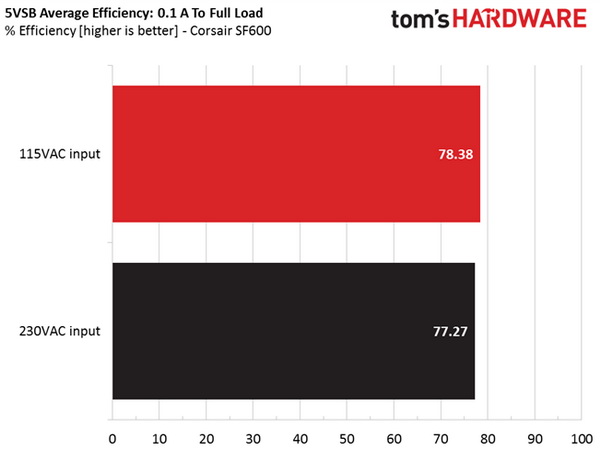
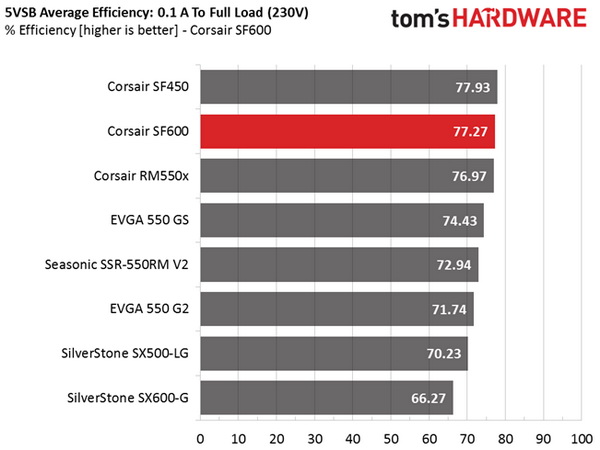
The 5VSB rail is highly efficient. Corsair's SF600 loses only to its small brother, and just barely.
Power Consumption In Idle And Standby
In the table below, you'll find the power consumption and voltage values of all rails (except -12V) when the PSU is idle (powered on, but without any load on its rails), and the power consumption when the PSU is in standby mode (without any load, at 5VSB).
| Mode | 12V | 5V | 3.3V | 5VSB | Watts | PF/AC Volts |
|---|---|---|---|---|---|---|
| Idle | 12.018V | 5.052V | 3.348V | 5.059V | 6.90 | 0.615 |
| 115.1V | ||||||
| Standby | 0.07 | 0.011 | ||||
| 115.1V |
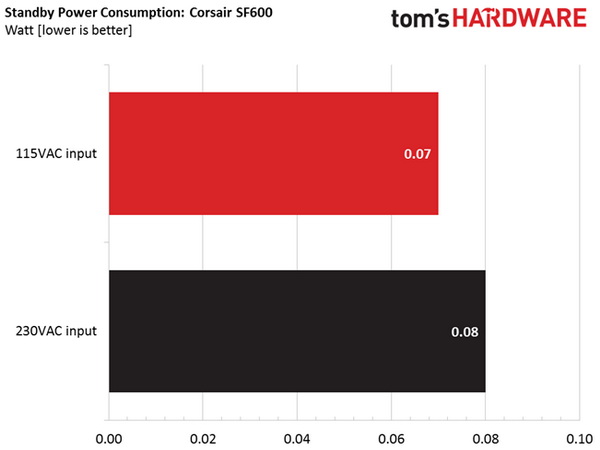
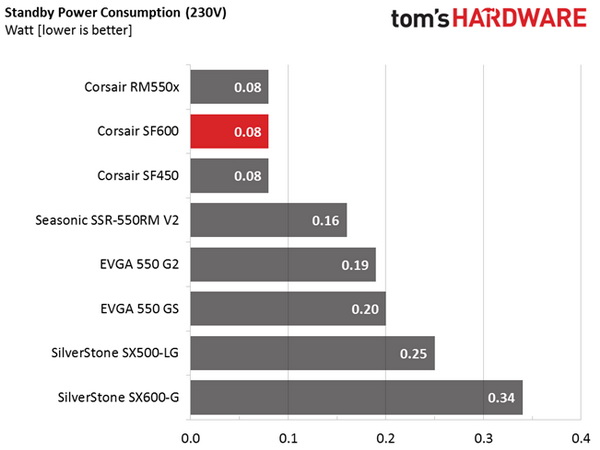
Vampire power is very low with both voltage inputs.
Fan RPM, Delta Temperature And Output Noise
Our mixed noise testing is described in detail here.
The first chart below illustrates the cooling fan's speed (in RPM), and the delta between input and output temperature. The results were obtained at 37 °C (98.6 °F) to 47 °C (116.6 °F) ambient temperature.
The next chart shows the cooling fan's speed (again, in RPM) and output noise. We measured acoustics from one meter away, inside a small, custom-made anechoic chamber with internals completely covered in sound-proofing material (be quiet! Noise Absorber kit). Background noise inside the chamber was below 18 dB(A) during testing, and the results were obtained with the PSU operating at 37 °C (98.6 °F) to 47 °C (116.6 °F) ambient temperature.
The following graph illustrates the fan's output noise over the PSU's operating range. The same conditions of the above graph apply to our measurements, though the ambient temperature was between at 28 °C (82.4 °F) to 30 °C (86 °F).
Zero RPM mode doesn't last long, and the PSU's fan ramps up quickly, as you can see in the graph above. At loads in excess of 350W, the fan noise is between 43 dB(A) and 46 dB(A)—that's anything but quiet. Given the SF600's observed efficiency, we believe the fan profile could be relaxed a bit without affecting reliability.
Current page: Efficiency, Temperature And Noise
Prev Page Load Regulation, Hold-Up Time And Inrush Current Next Page Cross-Load Tests And Infrared Images
Aris Mpitziopoulos is a contributing editor at Tom's Hardware, covering PSUs.
